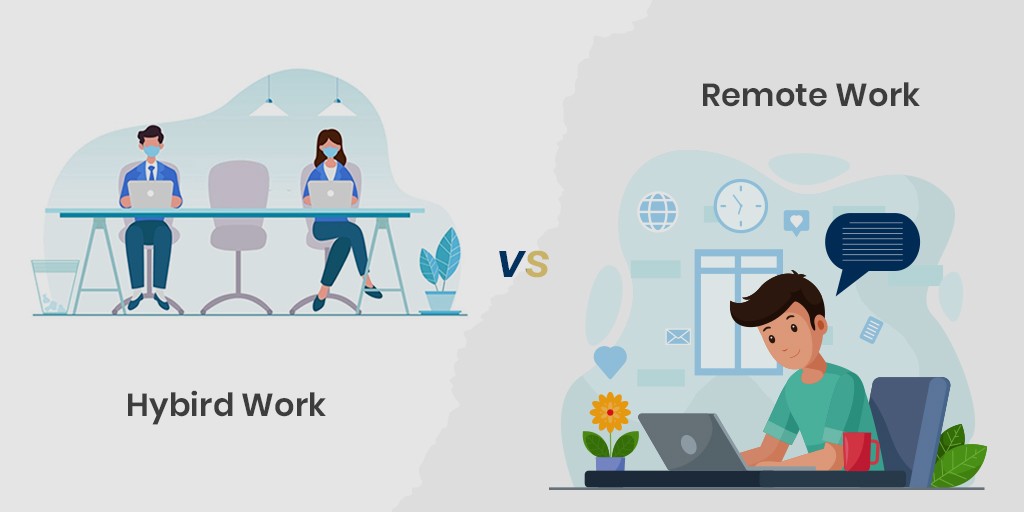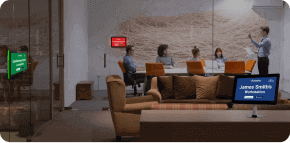Blog

Hybrid vs Remote Work: The Guide for Evolving Organizations
The main difference between remote work and hybrid work is that the former is outside the workplace or office while the latter is a combination of remote work and working on-site.
The concept of remote work is not new. However, it had a significant rise during the Covid19 pandemic’s peak. To be successful, employees must work anywhere outside the office, as long as it has a stable internet connection and a space conducive to working. Teams will need
to communicate virtually and be successful in their jobs.
The execution of hybrid work, on the other hand, is effective for those who want to split their time between traditional in-office and remote work. It includes some days working from home and other days working in the office.
What is the difference between remote work and hybrid work?
The difference between remote work and hybrid work is mainly in where and how often employees work.
Remote Work means employees work entirely outside the office, usually from home or any location, full-time. There’s no regular requirement to visit a physical office.
Hybrid Work combines both remote and in-office work. Employees split their time, working some days from home and some days at the office, depending on company policy or personal preference.
In short: remote = fully virtual, hybrid = mix of office and remote.
Types of Remote Work Choices
A corporation can adopt several types of remote work choices, and there is no such thing as a one-size-fits-all alternative. Furthermore, remote teams frequently communicate in methods that are different from those used by colocated teams.
But what do we mean when we say “remote work”? Many distinct sorts of work arrangements fall under the umbrella phrase “remote work.” To characterize remote work environment modes, people interchangeably use terms like “work from home,” “telecommuting,” “hybrid work,” and so on.
In this article, we’ll look at the many styles of remote work, as well as their benefits and drawbacks, so you can determine which approach is best for your company. We’ll also go through some of the most frequent remote communication strategies, so you know which ones to employ with your team.
What Are The Various Kinds Of Telecommuting Jobs For A Hybrid Company?
Working remotely is possible with the correct information and resources from any location. Nowadays, you may do it with the help of internet-based hybrid software, tools, or applications. So let’s get started and learn more about the various kinds of remote working.
Remote Work
Remote work is the most common word for work done outside of a regular office setting is “remote work.” It’s more generic, and it can pertain to various working arrangements, people, and workplaces.
There are no facilities in fully remote employment, and all workers work from their preferred site, wherever that may be. For entirely remote teams, effective communication is critical. As a result, each organization should handpick appropriate tools and develop best practices to ensure that all employees are efficient and productive with their respective tasks. Many remote teams also adopt hybrid software development and models.
Telecommuting
Personnel who worked away from the central office were referred to as telecommuters in the past. Workers who mix regular in-person employment with part-time work from a remote location to decrease commuting time are telecommuters.
Hybrid Work
There’s a lot of chatter about a hybrid workflow, but the term can be a bit vague. There are specific characteristics of working remotely and in an office in the hybrid model, but each organization takes a different approach. In general, there are five categories of hybrid remote work.
- Fully distributed: Not quite a hybrid paradigm, fully distributed is just another way of saying “completely distant.”
- Default digital: Team members can work from anywhere. There is no requirement that they work in a particular place.
- Static hybrid: Each partner has a fixed workplace, which could be an office or at home.
- Dynamic hybrid: Team members can work from their residences or in the office and choose their schedules.
- Synchronized hybrid: Employees work from home and at the office, but they arrive on the same schedule.
Office-First
The office is the principal workplace in this circumstance, but the corporation also provides employees with remote work possibilities. This isn’t often an intentional choice but instead develops over time as coworkers leave or hiring becomes difficult. The disadvantage is that because most work is done in the office and just a few people work remotely, it generates “two-speed” personnel.
Hence, not everyone communicates with their colleagues and with the administrative personnel in the same way. Remote employees do not form strong bonds with their on-site coworkers and mostly don’t receive career advancement possibilities.
Hybrid Company: Different Methods to Communicate Effectively In Remote Work Setup
Remote working groups can interact and collaborate effectively in one of three ways: synchronously, asynchronously, or hybrid automation of the two.
Synchronous
Synchronous communication occurs in real-time, resulting in fast responses. The most common synchronous communication methods include phone calls, videoconferences, and virtual meetings. These are ideal for instantaneous communication, such as a virtual meeting or a brainstorming session, are suitable for circumstances. Synchronous communication is rapid and dynamic, making it an excellent choice for active engagement. It has many parallels to traditional face-to-face communication.
However, because of the real-time nature of the system, all members must be virtually present at the exact moment, regardless of whether it is a convenient time for them. This could harm a team with members who work in various time zones. Discipline is required to be effective since communication difficulties and distractions might occur, especially with larger groups. Synchronous communication can also be time-consuming and upsetting in the event of technical faults.
Asynchronous
To be productive in an asynchronous context, different parties do not have to be present simultaneously. Emails, commercial messaging applications, project management tools, and other asynchronous communication methods are available. When an instant answer isn’t required, asynchronous communication is an excellent alternative. It allows everyone on the team to communicate whenever they choose, without changing their schedule. You also have more liberty with your responses because you are not under time constraints.
When compared to synchronous communication, asynchronous communication is less susceptible to technological faults. If something goes wrong or you want to fix something, you can take your time, make your corrections, and then go on. Finally, the size of the team has no bearing. It can still be effective even if a team is vast, unlike synchronous communication.
Asynchronous communication, however, falls short in situations where a quick response is required. It may also appear impersonal and far less engaging, but companies can avoid these concerns if done right.
So, Is It Synchronous Or Asynchronous?
Working remotely means that communication will never be flawless. Both communication methods have pros and cons. What is best for your organization depends entirely on your requirements and objectives. To cover these, many companies use a hybrid of both kinds. You can communicate more successfully if you have the correct tools and know where each form fits best.
Some argue that the asynchronous approach is more effective at fostering team culture and trust. While this viewpoint is valid in some contexts, it does not fit in all circumstances.
The secret to practical hybrid remote work is identifying the balance of asynchronous and synchronous approaches.
The internet environment provides businesses with various options for productive communication without the need to communicate in real-time. Asynchronous communication allows you to accomplish more often.
Choosing the Best Work Arrangement for Your Hybrid Company
The best remote work and communication approach to choose and apply varies for each organization and is determined by your area of industry and circumstances. In any event, the workplace is becoming more flexible and changing all the time. Hiring app developers, marketers, sales, and other members for your team has become easier now. Having the correct tools is more vital than ever since they may help your hybrid company’s team collaborate and communicate more effectively.




















































 Support
Support  Demo
Demo  Blog
Blog 